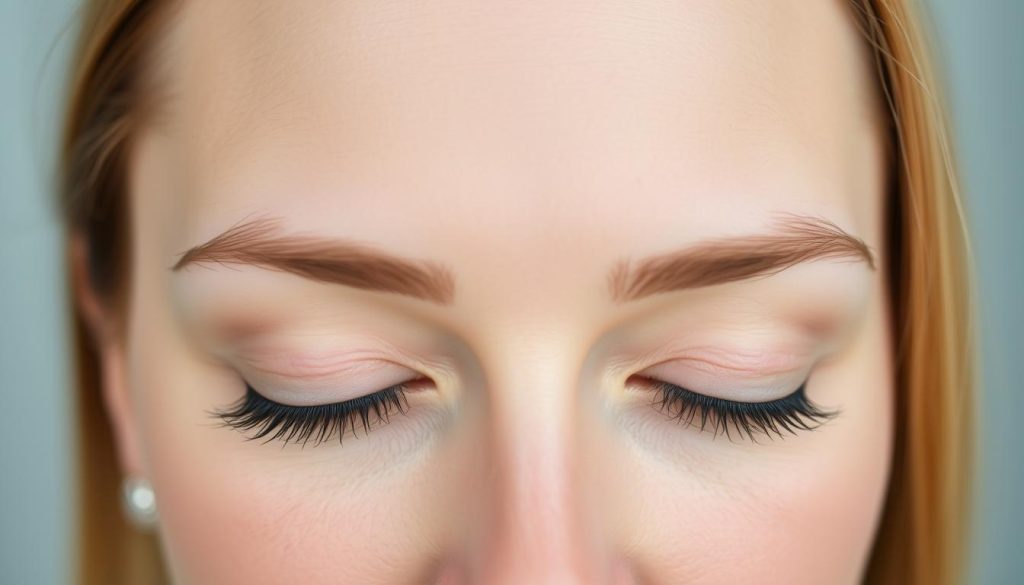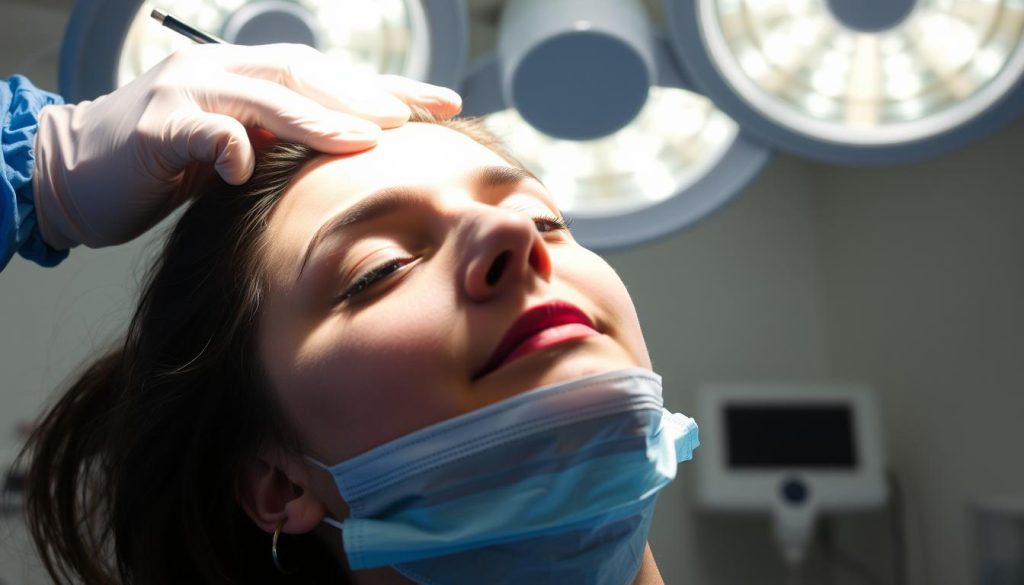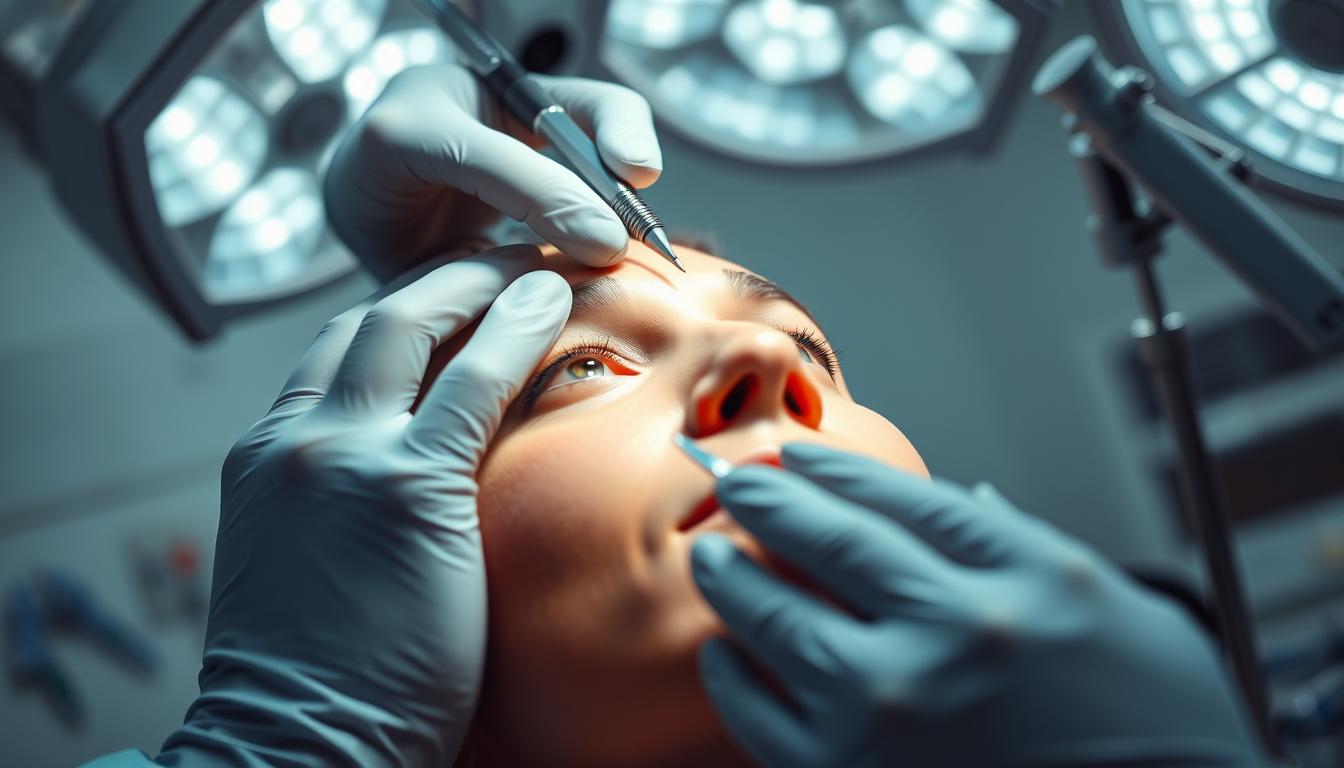A brow lift is a cosmetic surgical procedure that repositions the forehead to raise the brow, reduce wrinkles, and give a more youthful appearance. As individuals age, skin loses elasticity, and the accumulated effect of sun damage weakens the skin, causing the brow to sag.
This results in wrinkles and “frown lines” between the eyebrows, making a person appear tired, angry, or older than they feel. A forehead lift rejuvenates the upper portion of the face by addressing these signs of aging.
Key Takeaways
- A brow lift is a surgical procedure that targets the forehead area and eyebrows.
- It reduces wrinkles and smooths frown lines, lifting sagging brows.
- The procedure can be performed using various techniques based on the patient’s facial structure.
- It’s a popular solution for age-related changes affecting facial expressions.
- Understanding the benefits, procedure types, and recovery expectations is crucial.
Understanding Forehead Lift Surgery
A forehead lift, also known as a brow lift, is a surgical procedure that aims to restore a youthful look to the upper face. This procedure is designed to address the visible signs of aging, such as wrinkles and sagging eyebrows.
What Is a Forehead Lift?
A forehead lift is a surgical procedure that targets the upper face by repositioning tissues and removing excess skin. It specifically addresses horizontal forehead lines, vertical frown lines between the eyebrows, and sagging eyebrows that create a hooded appearance over the eyes. By adjusting the underlying muscles and tissues, a forehead lift creates a smoother, more youthful contour to the upper third of the face.
Signs You Might Need a Brow Lift
Several signs may indicate the need for a brow lift. These include persistent frown lines and forehead wrinkles, a heavy or drooping brow that makes you appear tired or angry, and sagging eyebrows that cause the upper eyelids to appear hooded. Many individuals seek this procedure when their resting facial expression appears sad, angry, or concerned despite their actual emotional state.
| Signs | Description |
|---|---|
| Forehead Wrinkles | Horizontal lines across the forehead |
| Frown Lines | Vertical lines between the eyebrows |
| Sagging Eyebrows | Causes a hooded appearance over the eyes |
Benefits of a Plastic Surgery Forehead Lift

The benefits of a plastic surgery forehead lift are multifaceted, ranging from aesthetic improvements to psychological boosts. A forehead lift, or brow lift, is designed to address the signs of aging in the upper face, providing a more youthful and refreshed appearance.
Aesthetic Improvements
A forehead lift offers several aesthetic benefits, including the reduction of deep horizontal forehead lines and the softening of vertical frown lines between the eyebrows. By elevating sagging brows, it can also improve the appearance of the upper eyes, creating a more open and alert look. The procedure can make patients look more refreshed and youthful by lifting tissue that may be hanging over the upper eyelids.
Psychological Benefits
The psychological benefits of a forehead lift are significant. Patients often experience increased self-confidence as they no longer feel they appear tired, angry, or older than they feel. Many report that others perceive them as more approachable and friendly after surgery, as their resting facial expression no longer appears stern or concerned. The rejuvenated appearance achieved through a brow lift can align a person’s outer appearance with their inner vitality.
Types of Forehead Lift Procedures
Forehead lift surgery encompasses several techniques, each tailored to address specific needs and desired outcomes. The choice of procedure depends on factors such as the patient’s anatomy, degree of correction needed, and the surgeon’s recommendation.
Classic or Coronal Brow Lift
The classic or coronal brow lift involves a continuous incision from ear to ear across the top of the head, behind the hairline. This traditional brow lift surgery allows the surgeon to lift the forehead skin, remove excess tissue, and reposition the underlying muscles. Although it results in a longer scar and potentially more extensive recovery time, it provides comprehensive access to the forehead tissues.
Endoscopic Brow Lift
The endoscopic brow lift is a minimally invasive approach using several small incisions in the scalp. The surgeon inserts a thin tube with a camera (endoscope) to visualize the tissues while making necessary adjustments. This technique results in less scarring, reduced recovery time, and minimal bruising compared to the classic approach, making it an increasingly popular option among patients and surgeons.
| Procedure | Incision Size | Recovery Time | Scarring |
|---|---|---|---|
| Classic or Coronal Brow Lift | Large, continuous | Longer | More noticeable |
| Endoscopic Brow Lift | Small, multiple | Shorter | Less noticeable |
| Temporal Brow Lift | Small, in temple area | Shorter | Minimal |
Temporal Brow Lift
The temporal brow lift focuses specifically on lifting the outer portions of the eyebrows through small incisions in the temple area. This procedure is ideal for patients who primarily have drooping in the lateral brow area. By targeting this specific region, the temporal brow lift offers a more localized solution with minimal scarring.
In conclusion, the choice of lift procedure depends on individual patient needs and the surgeon’s expert recommendation. Understanding the different types of forehead lift procedures can help patients make informed decisions about their brow lift surgery.
Non-Surgical Alternatives

Non-surgical brow lift procedures provide a less invasive method to achieve a smoother, more youthful appearance. These alternatives are ideal for individuals who wish to avoid the risks and recovery time associated with surgical brow lifts.
Botulinum Toxin Injections
Botulinum toxin injections, such as Botox®, Dysport®, or Xeomin®, offer a non-surgical approach to temporarily reducing forehead wrinkles and slightly elevating the brow position by relaxing specific muscles. These injections work by preventing muscle contractions that cause frown lines and horizontal forehead wrinkles, creating a smoother appearance and a subtle lift effect that can last 3-4 months.
Thread Lifts
Thread lifts represent another non-surgical alternative that uses specialized dissolvable sutures to physically lift and reposition sagging brow tissue for a more immediate lifting effect. During a thread lift procedure, the provider inserts thin threads beneath the skin using small needles, then pulls these threads to lift the tissue and secure it in a higher position.
While non-surgical alternatives offer convenience and minimal recovery time, they typically provide more subtle and temporary results compared to surgical forehead lifts, requiring maintenance treatments to sustain the effects. These options are particularly suitable for patients with mild to moderate brow drooping who are not ready for surgery or wish to “preview” the effects of a more permanent surgical procedure.
The Forehead Lift Procedure
The process of a forehead lift involves a series of surgical steps tailored to the individual’s needs. It begins with a comprehensive pre-surgery consultation where the surgeon evaluates the patient’s facial structure, skin elasticity, and overall health.
Pre-Surgery Consultation
During this consultation, the surgeon discusses the patient’s aesthetic goals, reviews medical history, and explains the expected outcomes and limitations of the brow lift surgery. This step is crucial in determining the most appropriate lift procedure.
Anesthesia Options
Anesthesia options for the surgery include general anesthesia or local anesthesia with intravenous sedation. The choice depends on the technique used, the extent of the procedure, and patient preference.
Surgical Process
The surgical process involves making incisions, lifting the forehead skin, adjusting underlying tissues, and repositioning the brow. Most forehead lift procedures are performed as outpatient procedures, taking approximately 1-2 hours.
| Procedure Aspect | Description |
|---|---|
| Pre-Surgery Consultation | Evaluation of facial structure and health |
| Anesthesia Options | General or Local Anesthesia with sedation |
| Surgical Process | Involves incisions, skin lifting, and brow repositioning |
Recovery After a Forehead Lift
Understanding what to expect during the recovery period can help patients prepare for a forehead lift procedure. The recovery process involves several key aspects that patients should be aware of to ensure a smooth and successful outcome.
Immediate Post-Op Care
Immediate post-operative care focuses on minimizing swelling and discomfort. Patients are advised to use cold compresses, keep their head elevated, and follow the surgeon’s instructions regarding pain medication. Bandages or dressings applied to the incision sites are typically removed within 1-2 days.
Timeline for Recovery
The recovery timeline for a forehead lift generally spans 2-3 weeks. Most patients can return to sedentary work within 7-14 days. Visible bruising and swelling are most pronounced during the first 10 days and typically resolve significantly by the two-week mark.
Managing Side Effects
Managing side effects includes following wound care instructions, taking prescribed medications, and attending follow-up appointments. Patients are advised to avoid strenuous activities for at least 2-4 weeks following surgery.
| Recovery Aspect | Details | Timeline |
|---|---|---|
| Swelling and Bruising | Most pronounced in the first 10 days | Resolves significantly by 2 weeks |
| Return to Work | Sedentary work possible | Within 7-14 days |
| Strenuous Activities | Avoid heavy lifting and exercise | For at least 2-4 weeks |

By following the surgeon’s instructions and taking the necessary precautions, patients can minimize potential side effects and achieve the best possible results from their forehead lift procedure.
Potential Risks and Complications
Understanding the potential risks and complications associated with forehead lift surgery is essential for making an informed decision. While generally considered safe, brow lift surgery can have side effects and complications like any other surgical procedure.
Common Side Effects
Common side effects following a forehead lift include temporary numbness, swelling, and bruising around the incision sites. Many patients experience a sensation of tightness across the forehead, along with temporary numbness on the top of the scalp that may later transition to itching. These effects are typically temporary and manageable with proper care.
- Temporary numbness and discomfort around the incisions
- Swelling and bruising that may affect the cheeks and eyes
- Numbness on the top of the scalp, potentially replaced by itching over time
Serious Complications
More serious complications, though rare, may include infection, poor wound healing, persistent pain, skin necrosis, and adverse reactions to anesthesia. Nerve injury is a potential risk that can result in muscle weakness or asymmetry of facial expressions. Choosing a board-certified plastic surgeon and following all pre- and post-operative instructions can significantly reduce these risks.
- Infection and poor wound healing
- Persistent pain and skin necrosis
- Nerve injury leading to muscle weakness or asymmetry
Combining Forehead Lift with Other Procedures
To achieve a harmonious and balanced rejuvenation, surgeons often recommend combining a forehead lift with other facial procedures. This approach allows for a more comprehensive transformation, addressing multiple signs of aging across the face.
Complementary Facial Surgeries
Combining a forehead lift with other facial surgeries is a common practice that yields more balanced results. Procedures like facelift, eyelid surgery, and neck lift complement a forehead lift by addressing different areas of the face. For instance, eyelid surgery (blepharoplasty) is often performed alongside a brow lift to address sagging brows and excess eyelid skin, which together contribute to a tired appearance.

Creating a Comprehensive Rejuvenation Plan
A comprehensive rejuvenation plan requires a thorough evaluation by an experienced surgeon. The surgeon must consider how different facial areas interact and recommend the appropriate combination of procedures to achieve natural-looking results. Factors such as overall operating time, anesthesia exposure, and recovery management are crucial to ensure patient safety while maximizing aesthetic outcomes.
As noted by experts, “Combining surgical procedures like forehead lift with non-surgical treatments such as laser skin resurfacing or dermal fillers can enhance the overall results by improving skin texture and addressing fine lines.”
Is a Forehead Lift Right for You?
Understanding whether a forehead lift is right for you involves considering several key factors, including your aesthetic concerns, overall health, and expectations about what the procedure can achieve.
Ideal candidates are generally healthy individuals with good skin elasticity and noticeable brow sagging or forehead wrinkles. A thorough consultation with a surgeon is crucial to discuss your medical history and determine the most appropriate brow lift technique.
Having realistic expectations about the benefits and limitations of a forehead lift is essential for satisfaction with the results.
FAQ
What is the difference between a brow lift and a forehead lift?
While often used interchangeably, a brow lift typically focuses on elevating the eyebrows, whereas a forehead lift encompasses a broader range of procedures to rejuvenate the upper face, including the brow and forehead area.
How long does it take to recover from a brow lift procedure?
The recovery time varies, but most patients can expect to return to their normal activities within 1-2 weeks. Swelling and bruising typically subside within a few weeks.
Will a brow lift leave noticeable scars?
The visibility of scars depends on the surgical technique used. Endoscopic brow lift procedures, for example, involve smaller incisions, resulting in less noticeable scarring.
Can a brow lift be performed under local anesthesia?
Yes, a brow lift can be performed under local anesthesia with sedation or general anesthesia, depending on the individual’s needs and the surgeon’s recommendation.
How long do the results of a brow lift last?
The results of a brow lift can last for several years, depending on factors such as skin elasticity, aging, and lifestyle.
Are there any non-surgical alternatives to a brow lift?
Yes, alternatives include botulinum toxin injections and thread lifts, which can provide temporary rejuvenation of the brow and forehead area.
Can I combine a brow lift with other facial surgeries?
Yes, a brow lift can be combined with other complementary facial surgeries, such as eyelid surgery or facelifts, to achieve a more comprehensive facial rejuvenation.
